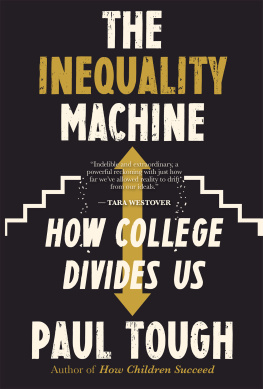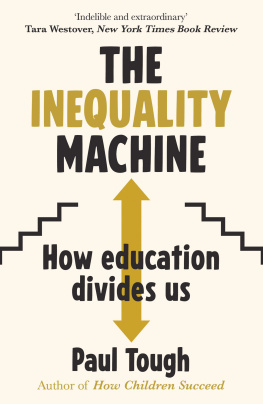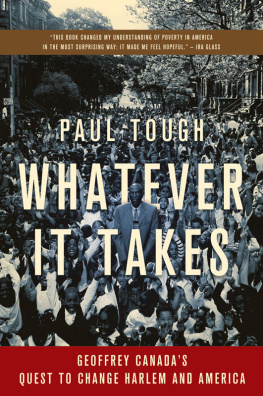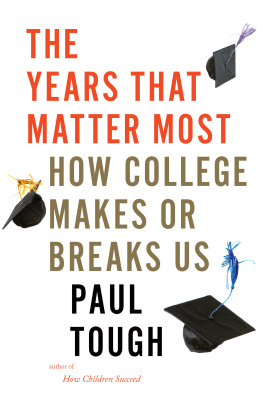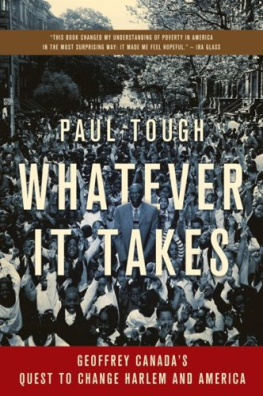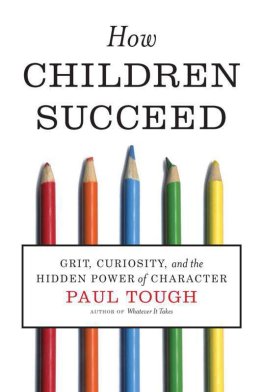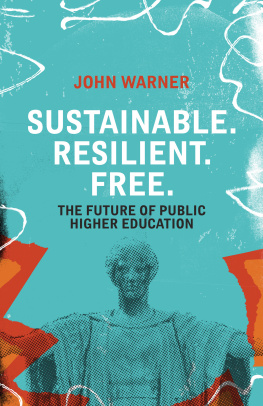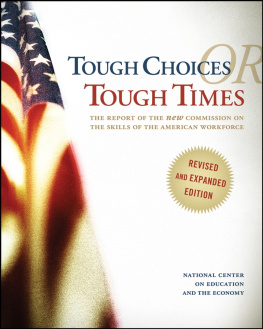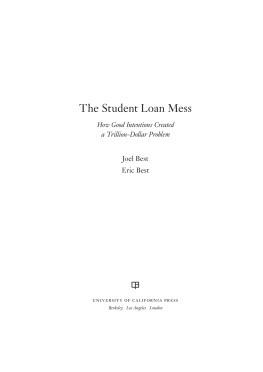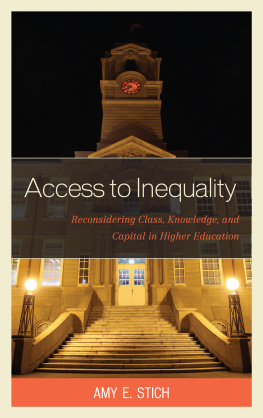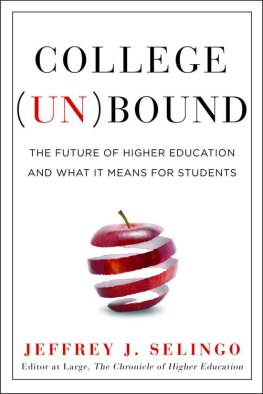First Mariner Books edition 2021
Copyright 2019 by Paul Tough
Preface and afterword copyright 2021 by Paul Tough
First published as The Years That Matter Most: How College Makes or Breaks Us
All rights reserved
For information about permission to reproduce selections from this book, write to or to Permissions, Houghton Mifflin Harcourt Publishing Company, 3 Park Avenue, 19th Floor, New York, New York 10016.
hmhbooks.com
Library of Congress Cataloging-in-Publication Data is available
ISBN 9780358362050 (paperback)
Cover art and design Rodrigo Corral
Author photograph Jeff Wilson
Part of originally appeared, in different form, in Who Gets to Graduate?, written by the author and published in May 2014 by the New York Times Magazine. Text reprinted by permission of the author. All rights reserved.
Excerpts from The Privileged Poor: How Elite Colleges Are Failing Disadvantaged Students, by Anthony Abraham Jack. Copyright 2019 by Anthony Abraham Jack. Reprinted by permission of Harvard University Press. All rights reserved.
eISBN 978-0-544-94436-7
v4.0221
For Paula
Preface to the Paperback Edition
WHEN I STARTED working on this book, way back in 2013, I imagined that my reporting would follow the general pattern of my previous books, Whatever It Takes, How Children Succeed, and Helping Children Succeed. Those books were about the obstacles that impeded the path of children growing up in low-income homes and neighborhoods and the strategies some educators and scientists were using to steer children past those obstacles. Much of the pleasure in reporting those books came from spending extended time with community leaders, pediatricians, economists, and chess teachers as they tried out new strategies and philosophies to help children succeed.
My work on this book began in much the same way. I had heard about a series of novel interventions that were designed to improve the fortunes of disadvantaged teenagers by subtly shifting their behaviorencouraging them to apply to more prestigious universities, to study harder for the SAT, to resist the temptation to drop out of college when the going got tough. These interventions all proceeded from the same premise: that uninformed students were making foolish errors that were undermining their college prospects. According to this way of thinking, the higher education system was eager to embrace these students and help them succeed, but the students werent taking advantage of the opportunities they were being offered.
It took me years of reporting to fully grasp the flaws in that premise, and in some ways, this book is the story of that gradual realization. It eventually became clear to me that the greatest obstacles low-income Americans face as they make their way to and through college are not psychological or cultural. They are economic and structural. When high-achieving low-income students dont attend highly selective colleges, it is not, for the most part, because they dont apply; it is because those colleges wont admit them. When they choose less prestigious colleges, it is not because those institutions are less intimidating but because theyre less expensive. And when they drop out of college before finishing their degree, it is not because of a lack of grit but because of a lack of financial support.
There is a paradox at the heart of our nations higher education system. On an individual level, the people who work in higher education are mostly compassionate and progressive and insightful. But together they have created a powerful inequality machine, a system that consistently reproduces social advantages and does so with a stubborn resistance to change. As I traveled the country reporting, this paradox created a kind of cognitive dissonance in me that was difficult to resolve and hard to shake. How could such well-meaning people be overseeing a system that produced such vast inequities?
When this book was published in hardcover in the fall of 2019, it was titled The Years That Matter Most. That title was a reflection of one of the books key findings: that recent changes in the economy and the culture have endowed the years after high school with an outsize importance in the trajectory of American lives. For individual young people, especially those who come from modest circumstances, a college education can be genuinely transformative in terms of both personal identity and economic opportunity. But in the eighteen months since the hardcover was published, the inequities in higher education have become more glaring and harder to ignore. So, for this paperback edition, the publishers and I chose a new title, one that more fully conveys the reality of higher educations dominant function today: The Inequality Machine.
American higher education didnt always operate this way. For decades, the nation had a robust system of high-quality state-funded public colleges and universities that either were free to attend or charged modest tuitions. After World War II, states from coast to coast rapidly expanded their public university systems. According to calculations by Thomas Mortenson of the Pell Institute, public funding for public colleges and universities almost tripled between 1961 and 1980 relative to personal income. Millions of new college students, most from middle-class and working-class families, flooded into these public systems, and for many of them, college was a gateway to prosperity.
Beginning in the 1960s and 1970s, though, two things began to changeand it is not hard to see how they might be connected. First, the student bodies at public institutions began to expand to include more people of colorspecifically, more Black and Latino students. And second, beginning with the Proposition 13 tax revolt in California in the late 1970s, states began to reduce the public funding they dedicated to higher education. The cuts were often severe and long-lasting. Between 1980 and 2015, states reduced their fiscal support for public higher education in the United States almost by half, relative to personal income. In response, public colleges have raised tuition, often dramatically, and students and their families have been forced to take on significant debt to pay that tuition. Academic budgets and student services have been cut, and graduation rates have declined at many public colleges, especially the less selective ones. Students now are often paying more and getting less.
The coronavirus pandemic brought into sharp relief the economic fault lines that run through and between institutions of higher learning in the United States. When campuses closed abruptly in March 2020, wealthy students were able to retreat to spacious childhood bedrooms with high-speed internet connections. Those with fewer resources crammed into crowded family apartments or camped out in Burger King parking lots to use the free Wi-Fi. Sitting side by side in a classroom, a student who had grown up in affluence and one who had grown up in poverty might have been able to ignore those class differences. But now they found themselves on Zoom calls where each students family background was projected behind them for all to see.
Remote learning that spring was a challenge for every college and every student. But institutional resources made a difference. Universities with large endowments were able to invest in technology and training for instructors, and their online classes were generally high-functioning. At community colleges and underresourced public universities, students often found their in-person courses replaced by a grab bag of YouTube videos and online quizzes.
High school seniors in the class of 2020, many of whom were trying to make their college plans during that surreal spring semester, encountered a different set of challenges. Students whose families were hit hard by illness or financial disruption were often forced to abandon their college ambitions, compelled by economic necessity to try to find work to help support their families. Those applying to prestigious private colleges sometimes found themselves pulled off the wait-list and offered a last-minute seatbut with a tiny financial aid package and a bill they couldnt possibly pay.

